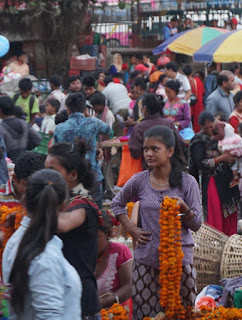The antique mandala story
 Last view of Namche. The most difficult part of the hike to Tengbouche is always those stone steps getting out of Namche, they make you want to just give it all up. But then you get to the top of the hill and the mountains come out of the clouds Ama Dablam appears and life seems so much better. It is a long downhill, up and down, to the river past beautiful stupas, then to the small lunch place by the river, where we go chocolate croissants las time, we took a small break for ginger tea, just to honor tradition and then started the hike up to tangbbouche, which happened too fast in record time, we arrived at 11:30, and wanted to keep going but had to wait for the bags and porters.
Last view of Namche. The most difficult part of the hike to Tengbouche is always those stone steps getting out of Namche, they make you want to just give it all up. But then you get to the top of the hill and the mountains come out of the clouds Ama Dablam appears and life seems so much better. It is a long downhill, up and down, to the river past beautiful stupas, then to the small lunch place by the river, where we go chocolate croissants las time, we took a small break for ginger tea, just to honor tradition and then started the hike up to tangbbouche, which happened too fast in record time, we arrived at 11:30, and wanted to keep going but had to wait for the bags and porters. 
 So I went inside the monastery and watched the always changing prayer flag and the always changing clouds from inside the courtyard. Later we went back to hear the monks do a long chant service , I did lots of drawings. Found a black and white spotted cow, not much else happening here, except clouds.
So I went inside the monastery and watched the always changing prayer flag and the always changing clouds from inside the courtyard. Later we went back to hear the monks do a long chant service , I did lots of drawings. Found a black and white spotted cow, not much else happening here, except clouds.  Didn't know if these were stone mandalas or landing pads for the helicopter. The New Zealand helicopter pilot said he had to lots of rescues of Trekkers getting altitude sickness. That is how many of the climbers die on mt. Everest. Speaking of altitude Tanner told me that the map said Ama Dablam base camp, where we go tomorrow, is 15,088 feet, camp one is 19,008, camp two is 19,614, and camp three is 21,123. The summit is 22, 488, with predicted high temperature at 6,000 meters of 1, Fahrenheit.
Didn't know if these were stone mandalas or landing pads for the helicopter. The New Zealand helicopter pilot said he had to lots of rescues of Trekkers getting altitude sickness. That is how many of the climbers die on mt. Everest. Speaking of altitude Tanner told me that the map said Ama Dablam base camp, where we go tomorrow, is 15,088 feet, camp one is 19,008, camp two is 19,614, and camp three is 21,123. The summit is 22, 488, with predicted high temperature at 6,000 meters of 1, Fahrenheit.




























































